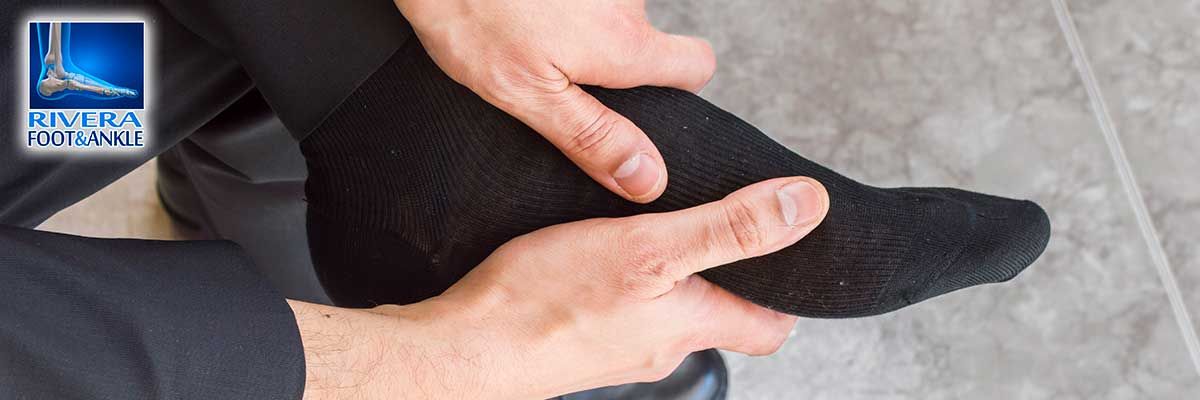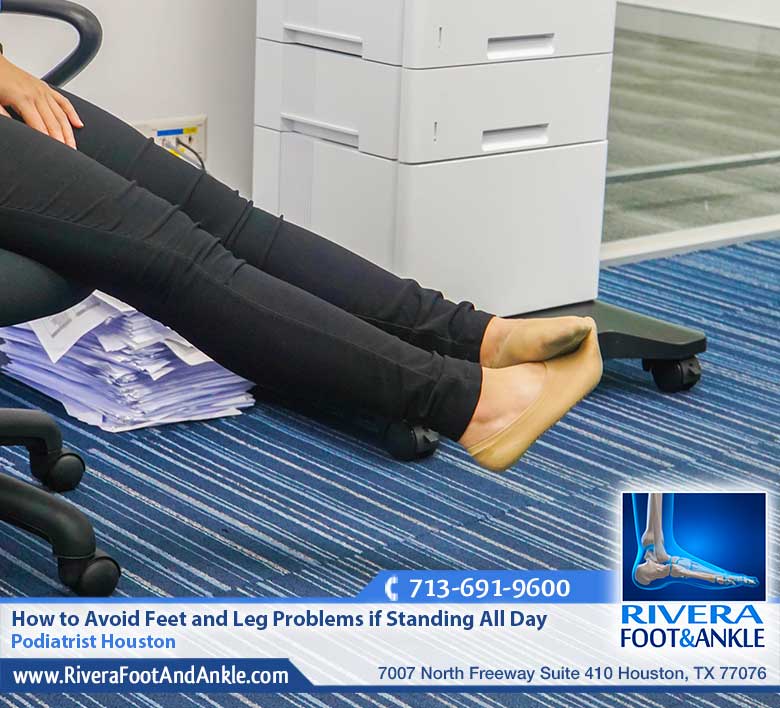
Podiatrist Houston
How to Avoid Feet and Leg Problems if Standing All Day
You can reduce the risks associated with prolonged standing – especially those suffering from chronic tired feet and stiff leg muscles. Below are simple actions you can take to get you through your day while avoiding …or at least reducing health hazards.
- Alternate standing with sitting: Find the time to sit if you are standing for long periods of time. Use break periods or slow periods to sit.
If you’re pregnant, try to put your feet up at work and rest with your feet higher than your head.
- Change positions frequently: Try walking around, stretching and standing in different positions to move your weight around.
- Wear comfortable and supportive shoes: Many stylish shoes are made nowadays that not only look great, but are power-packed with support and comfort features. Gone are the days of such shoes looking like something your great-grandmother would have preferred.
- Custom made orthotics support the skeleton, muscles and fascia in the correct position – key to relieving many foot and leg pain symptoms. In particular, if you stand on your feet for extensive periods, orthotics help to improve posture, relieve joint stress, support ligaments, treat overpronation, increase comfort while walking and can help to reduce other foot conditions such as heel (plantar fasciitis) and forefoot (metatarsalgia) pain. Ensure the orthotics are manufactured correctly, by seeing a foot expert who has a process designed with your best fit in mind.
- Lower the heel and spare your toes: Keep the really high heels and the very pointy toes for parties and special events. These are not ideal shoes for somebody who works on their feet all day long. Lack of space for toes reduces circulation and encourages a range of problems from cramping of feet; heels push the toes deeper into the end of the shoe and if that end is pointed, there is very little space for the toes to go.
- Cover hard floors: If you are confined to a certain space and it has a hard floor covering, request a rubber mat or a rug to be placed on the floor. This will cushion the area that you are standing on, reducing the impact on your legs and feet from the hard surface.
- Compression hose and socks: Compression socks are well known among people suffering from leg or foot problems but they have benefits that many people, including active individuals and those who stand on their feet all day, can take advantage of. With the growing awareness of compression socks and their health benefits, modern styles and colours have emerged.
- Alternating knee flexion: Bend your knee and try, without going beyond your natural range of motion, to touch your heel to your buttocks with one leg and then the other. This will help loosen up the quadriceps (the four major muscles in front of the thighs).
- Figure-8 hip rotations: Circling your hips in a figure-8 motion will prevent both hip tightness and blood stagnation in the lower extremities by shifting your balance from one side to the other.
- Hacky-sack kicks: Kicking an imaginary ball with your instep will help loosen the origin connection points of your gluteus maximus (buttocks), which is the largest muscle in the body. The “glutes” can become tight, especially where they attach to your sacroiliac joint, whether you’re in a sedentary seated or standing position. Just a few kicks on each side can prevent tight glutes.
- Hamstring stretch: A great way to activate the hamstrings and stretch them simultaneously (strengthening and lengthening) is to do an active hamstring stretch. Simply stick your buttocks out, keeping your back flat. Rock back on your heels. Keep your knees slightly bent. Squeeze the inside of your thighs together without actually moving the knees and reach your chin forward. Unlike the more popular passive way to stretch, this active stretch should provide immediate relief to your hamstrings.
- Calf stretch: If you can’t take a quick work break to do a downward-dog stretch, place both hands shoulder width apart and level on a wall, or, even at desk level. Place one foot forward and bend the knee so that the knee is directly over the ankle. The rear leg should be straight. You should feel the rear calf muscles stretching. As with the hamstring stretch, try to isometrically contract your thighs by activating the inner thighs without actually moving the knees.
RIVERA FOOT & ANKLE: At Orlando H.Rivera DPM, our priority is to deliver quality care to informed patients in a comfortable and convenient setting. When you have problems with your feet, you need to turn to a podiatrist who listens and responds… an experienced doctor who knows the field and can effectively diagnose and treat your needs… a friendly physician who counsels you on the best ways to maintain and improve your health. Our physician(s) meet all these criteria. Plus, you benefit from a dedicated team of trained professionals who give you the individualized attention you deserve.

Podiatrist Houston
Foot and Ankle, Dr. Orlando Rivera, Advanced Foot & Ankle Specialist, Foot and Ankle Podiatry, Houston Foot & Ankle Surgical, Treatment of Foot and Ankle, Foot & ankle specialists, Podiatrist in houston, podiatrist in houston, Orlando H.Rivera DPM, Houston Foot Doctor, Foot and Ankle Surgeon Houston, Ankle and Foot Specialist Houston, Podiatrist Houston, Foot Pain Houston.



